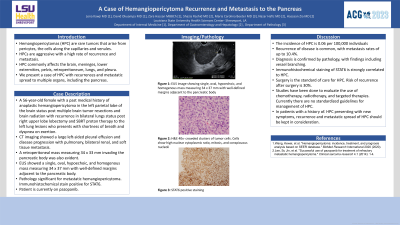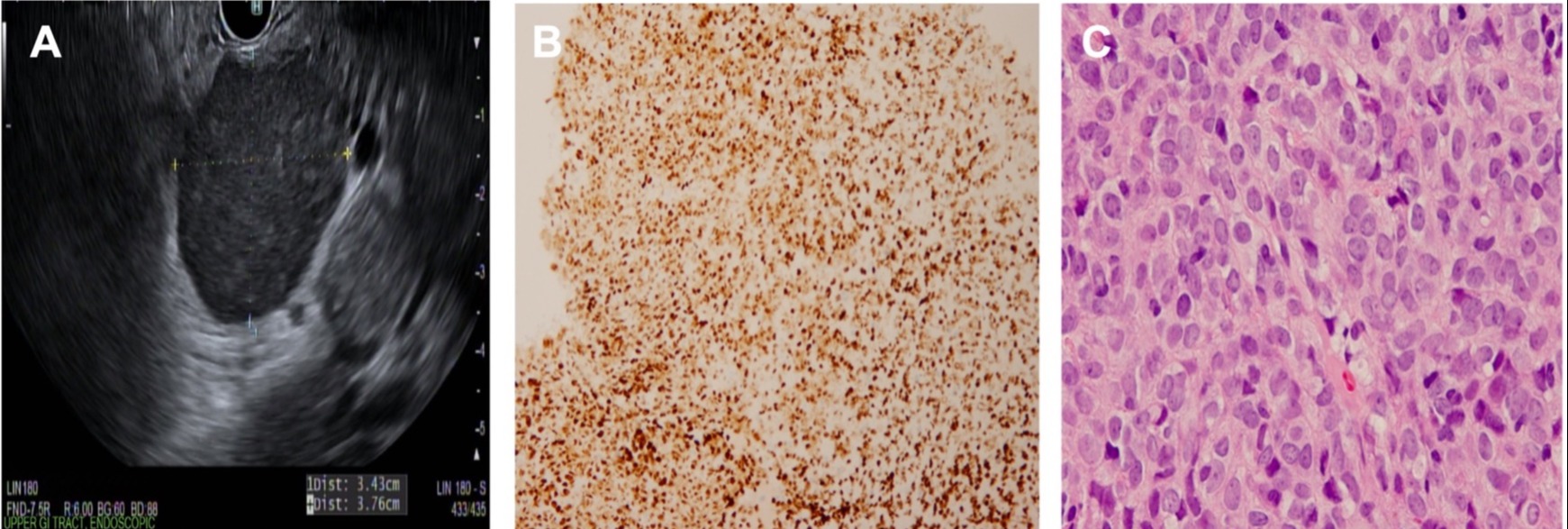Monday Poster Session
Category: Biliary/Pancreas
P1505 - A Case of Hemangiopericytoma Recurrence and Metastasis to the Pancreas
Monday, October 23, 2023
10:30 AM - 4:15 PM PT
Location: Exhibit Hall

Has Audio
- LK
Lena Kawji, MD, MS
LSU Health Sciences Center
Shreveport, LA
Presenting Author(s)
Lena Kawji, MD, MS, David Okuampa, MD, Zara Hassan, MBBCh, Shazia Rashid, MD, Maria Carolina Beeter, MD, Nazar Hafiz, MD, Hassaan A. Zia, MD
LSU Health Sciences Center, Shreveport, LA
Introduction: Hemangiopericytomas (HPC) are rare tumors that arise from pericytes, the cells along the capillaries and venules. HPCs are aggressive with a high rate of recurrence and metastasis. HPC commonly affects the brain, meninges, lower extremities, pelvis, retroperitoneum, lungs, and pleura. Here we present a case of hemangiopericytoma with recurrences and metastatic spread to multiple organs, including the pancreas.
Case Description/Methods: A 56-year-old female with a past medical history of anaplastic hemangiopericytoma in the left parietal lobe of the brain status post multiple brain tumor resections and brain radiation therapy with recurrence in bilateral lungs status post right upper lobe lobectomy and stereotactic body radiation proton therapy to the left lung lesions presented with shortness of breath and dyspnea on exertion. CT imaging showed a large left-sided pleural effusion and disease progression with pulmonary, bilateral renal, and soft tissue metastasis. A retroperitoneal mass measuring 34 x 33 mm invading the pancreatic body was also evident. Endoscopic ultrasound was performed for the establishment of diagnosis, which showed a single, oval, hypoechoic, and homogenous mass measuring 34 x 37 mm with well-defined margins adjacent to the pancreatic body. Pathology of the pancreatic mass showed metastatic hemangiopericytoma. Immunohistochemical stain was positive for STAT6. Patient is currently on pazopanib.
Discussion: The incidence of HPC is 0.06 per 100,000 individuals. Recurrence of disease is common, with metastasis rates up to 10.4%. Though imaging can assist in the evaluation of HPC, the diagnosis is confirmed by pathology. On pathology, there may be evidence of vessel branching. Positive immunostaining of STAT6 is strongly correlated to hemangiopericytoma. Surgery is the standard of care for HPC. The risk of recurrence after surgery is 30%. Different studies have been done to evaluate the use of chemotherapy, radiotherapy, and targeted therapies. Currently, there are no standardized guidelines for the management of HPC. In patients with a history of HPC presenting with new symptoms, recurrence and metastatic spread of HPC should be kept in consideration.

Disclosures:
Lena Kawji, MD, MS, David Okuampa, MD, Zara Hassan, MBBCh, Shazia Rashid, MD, Maria Carolina Beeter, MD, Nazar Hafiz, MD, Hassaan A. Zia, MD. P1505 - A Case of Hemangiopericytoma Recurrence and Metastasis to the Pancreas, ACG 2023 Annual Scientific Meeting Abstracts. Vancouver, BC, Canada: American College of Gastroenterology.
LSU Health Sciences Center, Shreveport, LA
Introduction: Hemangiopericytomas (HPC) are rare tumors that arise from pericytes, the cells along the capillaries and venules. HPCs are aggressive with a high rate of recurrence and metastasis. HPC commonly affects the brain, meninges, lower extremities, pelvis, retroperitoneum, lungs, and pleura. Here we present a case of hemangiopericytoma with recurrences and metastatic spread to multiple organs, including the pancreas.
Case Description/Methods: A 56-year-old female with a past medical history of anaplastic hemangiopericytoma in the left parietal lobe of the brain status post multiple brain tumor resections and brain radiation therapy with recurrence in bilateral lungs status post right upper lobe lobectomy and stereotactic body radiation proton therapy to the left lung lesions presented with shortness of breath and dyspnea on exertion. CT imaging showed a large left-sided pleural effusion and disease progression with pulmonary, bilateral renal, and soft tissue metastasis. A retroperitoneal mass measuring 34 x 33 mm invading the pancreatic body was also evident. Endoscopic ultrasound was performed for the establishment of diagnosis, which showed a single, oval, hypoechoic, and homogenous mass measuring 34 x 37 mm with well-defined margins adjacent to the pancreatic body. Pathology of the pancreatic mass showed metastatic hemangiopericytoma. Immunohistochemical stain was positive for STAT6. Patient is currently on pazopanib.
Discussion: The incidence of HPC is 0.06 per 100,000 individuals. Recurrence of disease is common, with metastasis rates up to 10.4%. Though imaging can assist in the evaluation of HPC, the diagnosis is confirmed by pathology. On pathology, there may be evidence of vessel branching. Positive immunostaining of STAT6 is strongly correlated to hemangiopericytoma. Surgery is the standard of care for HPC. The risk of recurrence after surgery is 30%. Different studies have been done to evaluate the use of chemotherapy, radiotherapy, and targeted therapies. Currently, there are no standardized guidelines for the management of HPC. In patients with a history of HPC presenting with new symptoms, recurrence and metastatic spread of HPC should be kept in consideration.

Figure: A. EUS image showing single, oval, hypoechoic, and homogenous mass measuring 34 x 37 mm with well-defined margins adjacent to the pancreatic body.
B. Stat6-positive. This stain shows positive for tumor cells in 93% of retroperitoneal SFTs.
C. H&E 40x- crowded clusters of tumor cells. Cells show high nuclear-cytoplasmic ratio, mitosis, and conspicuous nucleoli
B. Stat6-positive. This stain shows positive for tumor cells in 93% of retroperitoneal SFTs.
C. H&E 40x- crowded clusters of tumor cells. Cells show high nuclear-cytoplasmic ratio, mitosis, and conspicuous nucleoli
Disclosures:
Lena Kawji indicated no relevant financial relationships.
David Okuampa indicated no relevant financial relationships.
Zara Hassan indicated no relevant financial relationships.
Shazia Rashid indicated no relevant financial relationships.
Maria Carolina Beeter indicated no relevant financial relationships.
Nazar Hafiz indicated no relevant financial relationships.
Hassaan A. Zia indicated no relevant financial relationships.
Lena Kawji, MD, MS, David Okuampa, MD, Zara Hassan, MBBCh, Shazia Rashid, MD, Maria Carolina Beeter, MD, Nazar Hafiz, MD, Hassaan A. Zia, MD. P1505 - A Case of Hemangiopericytoma Recurrence and Metastasis to the Pancreas, ACG 2023 Annual Scientific Meeting Abstracts. Vancouver, BC, Canada: American College of Gastroenterology.
